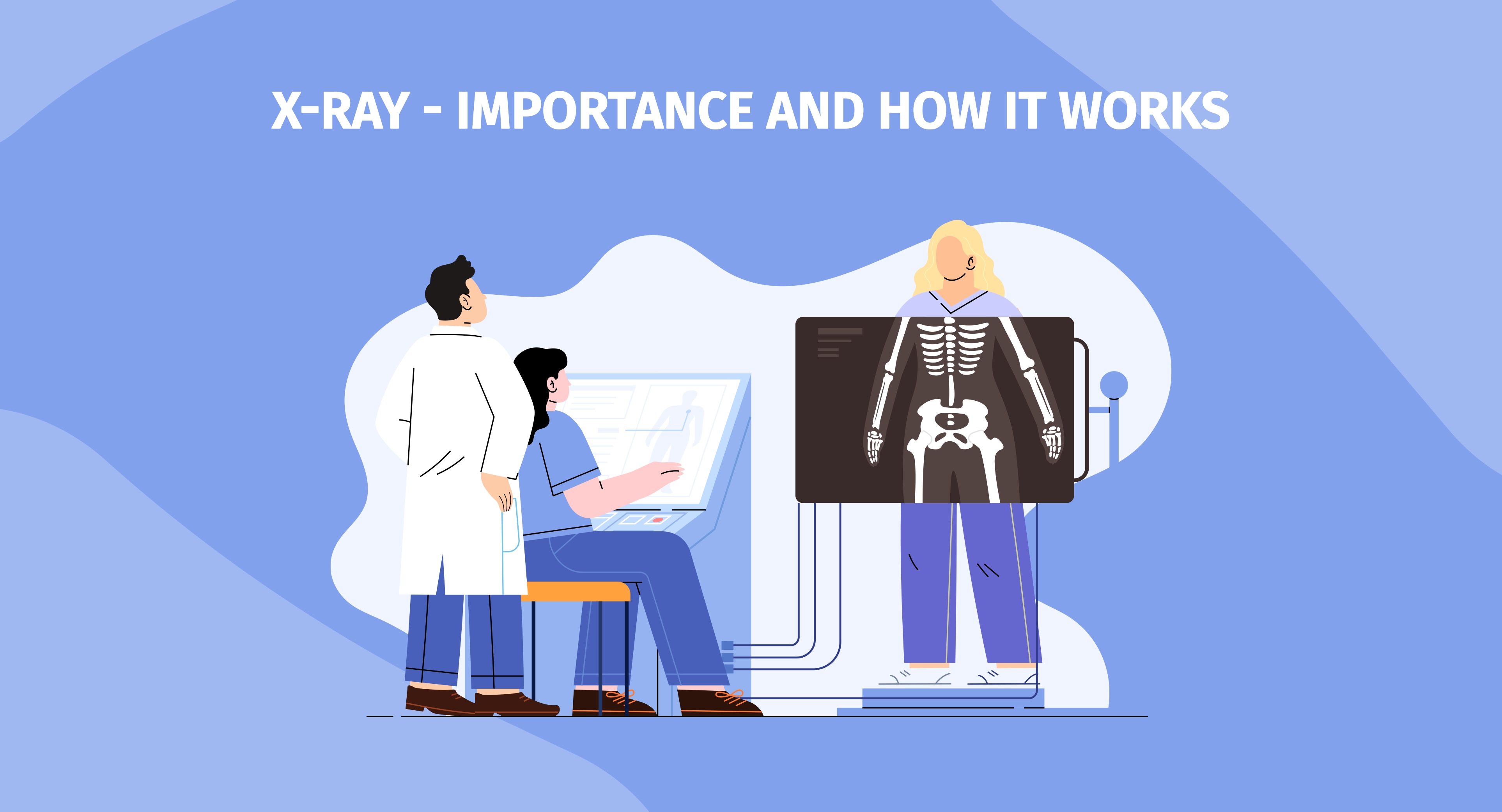X-ray: Meaning, How It Works and Importance in Medicine

X-ray imaging (radiography) is one of the most commonly used methods of medical visualization that allows doctors to examine the internal structures of the human body without physical intervention. This method is based on the ability of X-ray beams to pass through different tissues with varying intensity, which ultimately creates a detailed image.
An X-ray machine emits high-energy electromagnetic waves, so-called X-rays, which are absorbed by tissues in the body at different strengths as they pass through. High-density structures, such as bones, absorb these rays less, which is why they appear lighter on the image. Softer tissues, like muscles and organs, provide less resistance to the rays and therefore appear darker.
The principle behind the X-ray machine is very similar to that of a photo camera: the waves coming from the source pass through the body and reach a special detector, which creates the final image. In modern radiography, digital technologies are often used, which allow the image to be processed by a computer—this reduces the radiation dose and improves diagnostic accuracy.
Radiography is one of the most important and frequently used imaging methods in medicine. It is fast, accessible, and effective, which makes it an irreplaceable tool in the diagnostic and treatment process.
One of the main fields where X-rays are actively used is traumatology and orthopedics. In most cases, it is impossible to detect fractures, dislocations, and bone structure deformities without an X-ray. Doctors also use it to diagnose bone diseases, such as osteoporosis or arthritis.
Diagnosing lung diseases is also often unimaginable without X-rays. Pneumonia, tuberculosis, lung cancer—these are the pathologies that doctors most often try to detect with X-ray imaging. Chest X-rays also play an important role in identifying respiratory infections and other respiratory problems.
In dentistry, X-rays are often used to assess tooth roots, the development of cavities, hidden infections, and the structure of the jaw. This helps doctors to plan the right treatment strategy.
In gastroenterology, radiography is used to examine the condition of abdominal organs—such as the esophagus, stomach, and intestines.
An X-ray is prescribed when a quick and accurate diagnosis of internal structures or conditions is needed. For example, if a patient is experiencing strong pain in the musculoskeletal system, has an injury, or sudden symptoms, the doctor will often first order an X-ray to obtain maximum information about the affected area.
In addition, X-rays are frequently used for preventive screenings. For example, a chest X-ray is essential during routine examinations, especially for people whose profession carries a high risk of developing lung diseases.
Although X-ray imaging is a very important method for diagnostics, its frequent use is not allowed due to radiation exposure. Therefore, doctors always try, when necessary, to reduce the dose of radiation to a minimum or to use alternative methods, such as ultrasound or magnetic resonance imaging (MRI).
X-ray Imaging – Cost and the Factors That Influence It
How much does X-ray cost? – this is one of the most common questions patients ask when it comes to this diagnostic method. In this section, we will answer exactly that question.
The cost depends on many factors, starting from the quality and technology of the equipment to the complexity of the examination and the specifics of the medical institution. Although, in general, X-ray imaging is considered one of the most affordable methods, prices can vary significantly between clinics and may differ quite a lot. This is because both technical and organizational/economic factors influence the cost of an X-ray.
Modern radiography is based on various technologies, which directly affect both the image quality and the cost of the procedure. One of the main determining factors is the type of X-ray equipment used in the clinic.
Older, classic film-based radiography, which dominated medical practice for many years, is relatively budget-friendly, but its use is decreasing by the day. The reason is not only the lower image quality, but also the fact that maintaining and operating such equipment is more complicated and less flexible.
In modern clinics, digital radiography is becoming increasingly common. This method allows for the highest quality images with reduced radiation exposure. Moreover, digital X-rays are more convenient both for doctors—who can process images using computer software—and for patients. However, using digital technologies is more complex, which also affects the price of the procedure.
Portable X-ray machines, which are especially important for patients who cannot move, increase the cost of the service even further. In such cases, the technician not only has to transport the equipment but also ensure the appropriate environment for the procedure, which comes with additional costs.
“How much does an X-ray cost?” – another factor that can influence the price is which part of the body needs to be examined and how complex the procedure is. For example, if the patient only needs an image of a small area, such as a finger or wrist, the procedure will be relatively simple and quick, which is reflected in the price. However, if it involves a more complex scan, such as a full-length spine X-ray or a detailed lung examination, the cost will increase.
Especially complex and expensive procedures include those X-ray scans that require images to be taken from multiple angles. For instance, if a patient has an injury and the doctor wants to get a detailed view of the damage, it may be necessary to take several images from different perspectives, which complicates the procedure and affects the cost.
Another important factor that influences the cost is whether contrast-enhanced radiography is required. In some examinations, such as gastrointestinal or vascular studies, special contrast agents are used to highlight organ and tissue details more clearly. These substances, like barium mixtures or iodine-based contrast agents, make the procedure more informative—but also more expensive, which affects the final price.
Location of the Clinic and Service Level – How Environment Affects Price
The cost of medical services often depends on where and in what type of clinic the procedure is carried out. In public hospitals, radiography is usually more affordable, especially when the patient is insured or covered by state programs. However, in such cases, there may be waiting lines, and the procedure might only be available after a certain period.
In private clinics, on the other hand, service is faster and technologically more advanced, but also more expensive. The more reliable and high-tech the medical facility, the higher the service price.
The cost of radiography often includes not just the scan itself, but also the interpretation of the image. In some clinics, if the patient only needs the image and will take it to another doctor for consultation, the cost may be relatively low. But if it requires a radiologist’s interpretation and a written diagnostic report, the price increases.
Taking all these factors into account, it’s difficult to say definitively how much an X-ray costs—the price is influenced by many circumstances. That’s why it is best to contact the clinic in advance to find out the cost of the service.
Panoramic X-ray VS Chest X-Ray - What are they used for?
The first type of X-ray (orthopantomogram) is one of the most important diagnostic methods in dentistry and maxillofacial surgery. It is used to assess the teeth, jaw bones, wisdom teeth, implant planning, and other dental problems. With its help, doctors can clearly see the full structure of the oral cavity, which helps in properly planning treatment.
Panoramic X-ray – price and influencing factors are also among the frequently asked questions. The cost of this method depends primarily on the technology used—digital X-ray is more expensive, but it provides a more accurate image and less radiation exposure. Additional factors such as a doctor’s consultation, emergency imaging, or digital processing of the image also increase the cost.
Although prices vary, the main criterion for the patient should be the quality of the examination, because an accurate diagnosis directly affects the effectiveness of the treatment.
How much does a chest X-ray cost? – Questions about the price and effectiveness of this method are also common, as doctors frequently rely on it.
And this is no surprise—chest X-ray is used to detect diseases such as pneumonia, tuberculosis, and lung cancer. Its cost, first of all, depends on the technology—again, digital X-ray is more expensive, but it offers higher image quality and lower radiation.
Other influencing factors include the clinic’s technological equipment, the qualifications of the staff, and additional consultations after the X-ray. However, in the end, quality is what matters most, because an accurate diagnosis is the foundation of effective treatment.
In addition, it must be considered that frequent use of X-rays is not recommended. Therefore, it should only be performed with a doctor’s prescription and limited to the area necessary for diagnosis. Making such decisions independently is not advised.
The X-ray meaning in Medicine and Its Effectiveness
X-ray imaging is one of the most widely used and important diagnostic methods in modern medicine. It allows doctors to quickly and accurately assess the internal structures of the body, which enables effective treatment planning. The diagnosis of traumas, bone diseases, lung pathologies, dental problems, and many other conditions is often impossible without radiography.
Although X-ray imaging is an accessible and fast method, doctors always try to prescribe it only when necessary, in order to minimize radiation exposure. That is why it is important that the examination is performed according to a professional doctor’s recommendation and carried out with the highest precision.
In the end, radiography is one of the most powerful and essential tools in medicine, helping in the early detection of diseases and in effective treatment. X-ray is one of the most important methods in a doctor’s arsenal on the path to recovery.

